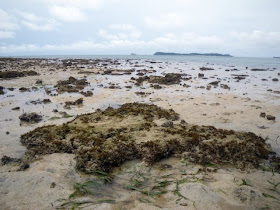Hunter seeking simply means to help find animals for the participants so that they need not trample all over the place to look at them instead. Of course, we will release the animals back to where they were previously found after the walk.

The day started off with rain but that did not dampen our spirit!
In fact, the many Knobbly sea stars (Protoreaster nodosus) that can be found gathering close together brightened up my day! How many of them can you count just from this photo?

And just in this tide pool, many of the stars are getting close to each other. Perhaps they are seeking safety in numbers or are they preparing to do it?

Here is a nice assortment of the different types of knobbly sea stars that I came across.

The other hunter seekers were also working hard and this juvenile Cushion star (Culcita novaeguinea) was found! It is the same one that we saw previously.

Also found are two pretty Spider conches (Lambis lambis)- showing one with its underside and the other with the dull but yet well camouflaged upper surface.

As for me, I found this Black phyllid nudibranch (Phyllidiella nigra) with purplish bumps.

It's my first time seeing the Hammer oyster (Malleus sp.) in such a shiny silver colour. Like a hammer, this oyster has a 'T' shape. The hinge is on the 'horizontal' portion of the 'T' and the valves held shut by one large adductor muscle that lies at the cross of the 'T'.

How is the coral bleaching going on now? I had a quick look at the reef area. Though there were still a number of bleached corals, it seems to me that some other corals are still surviving and are not bleached.

However, for those stressed-up corals, they can actually produce mucus as shown here to try and remove the stress that is causing it to do poorly.

Though this Giant carpet anemone (Stichodactyla gigantea) is bleached, I also came across more of them that are not.

Similar to previous trips, the Pizza anemones (Cryptodendrum adhaesivum) are in pale yellow than its usual brown.

Many of the soft corals are still doing relatively well without much bleaching.

And it is a delight to also see the Fire anemone (Actinodendron sp.) here at Semakau. It is called fire anemone for a purpose as it can give a nasty sting!

Towards the end of my hunter seeking job this morning, I found something that someone will be greatly interested in. Can you see anything from here?

Zooming in, yes, it is a Fluted giant clam (Tridacna squamosa)!

Here's an even closer look at the clam, with lots of scutes at the side of the shell which probably help fend off some its predators.
Though I didn't have the GPS with me, I later heard from Ron that he had already passed the coordinates of this clam to Mei Lin for her giant clam project. :)

During the landfill tour that followed after the intertidal walk, we noticed a number of bleached boulder corals at the edge down the seawall. Though we did not notice them previously (as they are well camouflaged with the rocks from far), it is ironical that now we know there are actually many corals here since the bleaching has made them more conspicuous to our sight. Let's just hope the bleaching will end soon.
More photos of the day's trip here: http://www.flickr.com/photos/koksheng/archives/date-posted/2010/07/17/
No comments:
Post a Comment